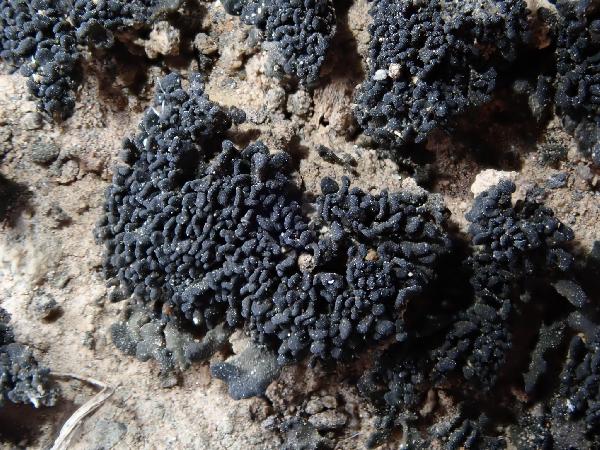Synalissina cladodes (Tuck.) M. Schultz & M. Prieto
in Prieto & al., Studies in Mycology, 109: 630, 2024. Basionym: Collema cladodes Tuck. - Gen. Lich.: 89, 1872
Synonyms: Lempholemma cladodes (Tuck.) Zahlbr.
Distribution: N - Ven (Ravera & al. 2022).
Description: Thallus small-fruticose, homoiomerous, gelatinous when wet, dark olivaceous brown to black, forming spreading cushions, consisting of decumbent to erect, terete, often finely striate, mostly dichotomously branched, 1-2 mm long, 0.1-0.2 mm thick lobes with swollen, up to 0.3 mm wide apices containing initially globose, finally bursting open and cup-like hormocystangia producing hormocysts measuring 25-35 x 10-15 μm. Apothecia very rare, zeorine, terminal, globose, 0.2-0.4 mm across, with a convex, blackish disc, a thick thalline margin and a pale, thin proper margin, developing from ascogones arising in a spheroid tangle of generative hyphae. Proper exciple very thin, of parallel hyphae, K/I-; epithecium yellowish brown; hymenium and hypothecium colourless, I+ reddish brown, K/I+ blue; paraphyses mostly simple, not apically thickened, coherent; hypothecium colourless, K/I+ blue. Asci 8-spored, clavate, thin-walled, with a distinct amyloid outer cap, but no apical dome, Peccania-type. Ascospores 1-celled, hyaline, globose, 15-20 μm wide. Photobiont cyanobacterial (Nostoc, the individual cells 4-5 μm wide, arranged in chains). Spot tests: all negative. Chemistry: without lichen substances.Note: on more or less calciferous rocks with periodical percolation of water in cool situations; widespread in the Northern Hemisphere (Scandinavia, North America), but not common; rarely collected in the Alps, being only known from Switzerland, recently found in the Eastern Italian Alps.
Growth form: Fruticose
Substrata: rocks
Photobiont: cyanobacteria, filamentous (e.g. Nostoc, Scytonema)
Reproductive strategy: mainly sexual
On otherwise dry surfaces with short periods of water seepage after rain
Commonnes-rarity: (info)
Alpine belt: very rare
Subalpine belt: very rare
Oromediterranean belt: absent
Montane belt: absent
Submediterranean belt: absent
Padanian area: absent
Humid submediterranean belt: absent
Humid mediterranean belt: absent
Dry mediterranean belt: absent

Predictive model
Herbarium samples
Growth form: Fruticose
Substrata: rocks
Photobiont: cyanobacteria, filamentous (e.g. Nostoc, Scytonema)
Reproductive strategy: mainly sexual
On otherwise dry surfaces with short periods of water seepage after rain
Commonnes-rarity: (info)
Alpine belt: very rare
Subalpine belt: very rare
Oromediterranean belt: absent
Montane belt: absent
Submediterranean belt: absent
Padanian area: absent
Humid submediterranean belt: absent
Humid mediterranean belt: absent
Dry mediterranean belt: absent

Predictive model
| Herbarium samples |

















